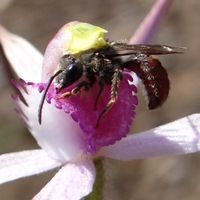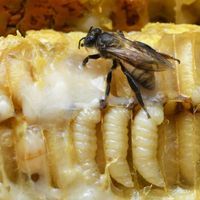bees

Widespread Declines in UK’s Pollinators: Study
Carolyn Wilke | Mar 26, 2019 | 2 min read
Over 30 years, one-third of the wild bees and hoverfly species surveyed sustained losses, likely due to pesticides, habitat loss, and climate change.

Image of the Day: Seeing is Bee-lieving
Carolyn Wilke | Feb 22, 2019 | 1 min read
Four decades after it was thought to have disappeared in the wild, scientists have found a single female Wallace’s giant bee in Indonesia.

Honeybees Enter Virtual Reality So Scientists Can Study Their Brains
Jess Romeo | Feb 14, 2019 | 3 min read
Researchers record neurological changes in a region called the mushroom body in the brains of bees completing a maze in a virtual environment.

Image of the Day: Attendance Record
Carolyn Wilke | Feb 11, 2019 | 1 min read
Genetic material left behind on flowers can reveal which insects have visited.

Image of the Day: Sweet Lure
Carolyn Wilke | Jan 18, 2019 | 1 min read
Thought to be a nectar con artist, the candy spider-orchid actually does feed its pollinators, a select group of bees.

Image of the Day: Corn Fed
Catherine Offord | Nov 29, 2018 | 1 min read
Bumblebee colonies grow poorly in landscapes dominated by maize, researchers find.

Pesticide Exposure Alters Bumblebees’ Behavior in Their Nests
Ruth Williams | Nov 8, 2018 | 3 min read
A high-tech approach to monitoring bee activity inside the nest reveals how the neonicotinoid imidacloprid impairs colony growth.

Bees Stopped Buzzing During the 2017 Eclipse
Catherine Offord | Oct 11, 2018 | 2 min read
The insects fell silent as the moon cast a shadow over parts of North America last summer, researchers report.

Image of the Day: All in a Day’s Work
Shawna Williams | Oct 8, 2018 | 1 min read
A bee researcher finds that his subjects are protected from viral infections when they dine on fungus.

Celebrated Brazilian Bee Scientist Warwick Kerr Dies
Vijay Shankar Balakrishnan | Oct 2, 2018 | 4 min read
Revered as a humanitarian and scientist, Kerr was also blamed for the introduction of aggressive Africanized bees to the Americas.

As Bees Specialize, So Does Their DNA Packaging
Shawna Williams | Sep 11, 2018 | 3 min read
A study of chemical tags on histone proteins hints at how the same genome can yield very different animals.

New Pesticide Affects Bumblebee Reproduction
Shawna Williams | Aug 15, 2018 | 2 min read
Sulfoxaflor, an alternative insect-killer to older chemicals that decimate pollinators, turns out to kneecap colonies.

Bumblebees Fare Better in the City Than in the Countryside
Catherine Offord | Jun 27, 2018 | 2 min read
Urban colonies had more offspring, survived longer, and hosted fewer parasites.

Bees Appear Able to Comprehend the Concept of Zero
Ashley Yeager | Jun 7, 2018 | 3 min read
The insects correctly ordered an absence of black dots as “less than” a group of black dots.

EU States Vote to Ban Neonicotinoids
Diana Kwon | Apr 27, 2018 | 2 min read
The pesticides, which studies show are harmful to bees, will be prohibited in open fields by the end of 2018.

Bees’ Molecular Responses to Neonicotinoids Determined
Catherine Offord | Mar 22, 2018 | 4 min read
Researchers pinpoint a protein that can metabolize at least one of the insecticides, highlighting a route to identifying compounds that are friendlier to the critical pollinators.

Bees Under Attack
The Scientist | Jan 31, 2018 | 1 min read
Japanese honeybees (Apis cerana japonica) respond to an attack by a Vespa mandarinia wasp.

Image of the Day: What Does a Bee See?
The Scientist and The Scientist Staff | Dec 21, 2017 | 1 min read
Scientists identify floral temperature patterns as a sensory cue that may help bees identify flower species.

Image of the Day: Moth Resurrection
The Scientist and The Scientist Staff | Dec 18, 2017 | 1 min read
Entomologists have rediscovered a species of moth that was considered lost for 130 years.

Image of the Day: Leggy Bees
The Scientist | Sep 14, 2017 | 1 min read
Female South African bees evolved lengthy limbs to better amass oil from the snapdragon flowers they pollinate.
